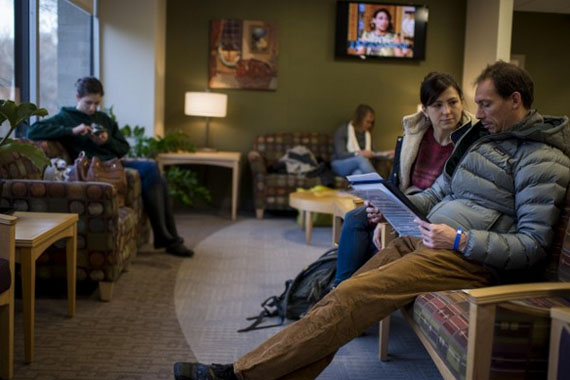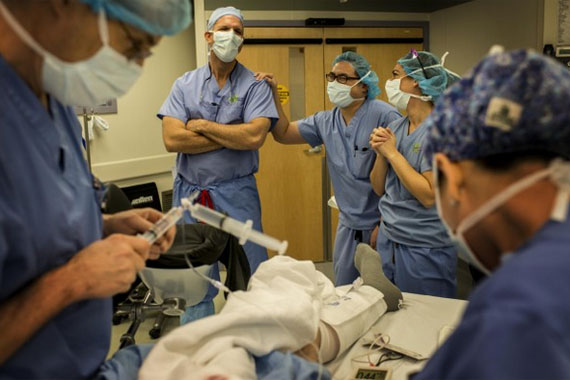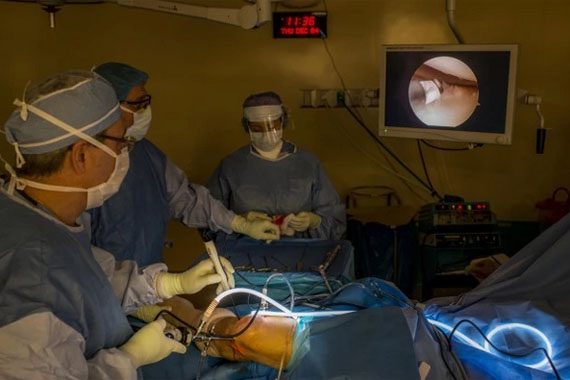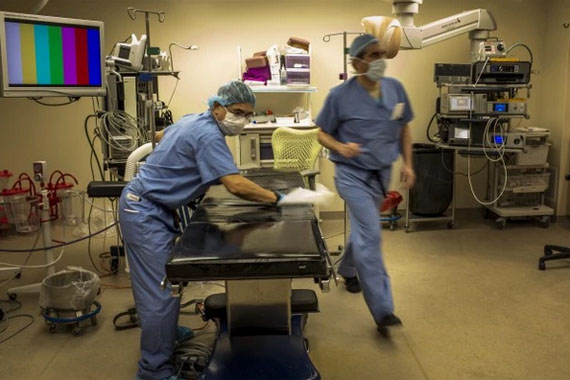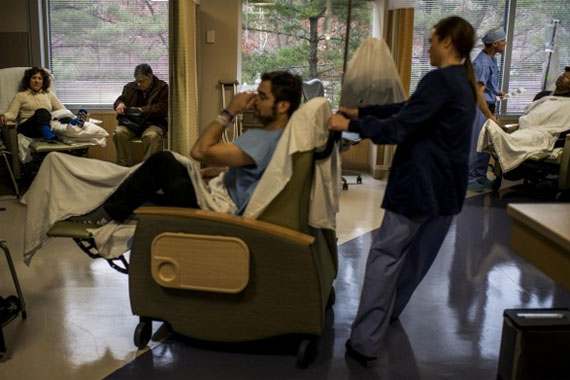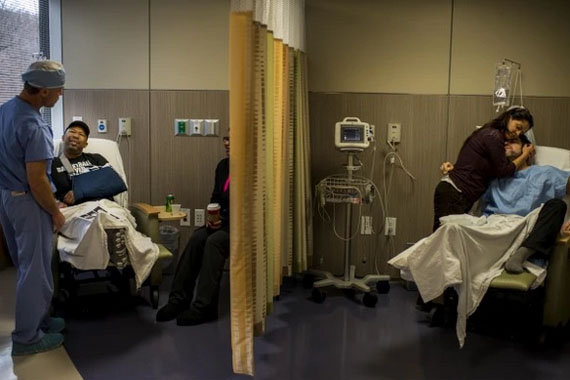Wendy Salo was alarmed when she learned where her doctor had scheduled her gynecologic operation: at an outpatient surgery center. “My first thought was ‘Am I not important enough to go to a real hospital?’ ” recalled Salo, 48, a supermarket department manager who said she felt “very trepidatious” about having her ovaries removed outside a hospital.
Before the Sept. 30 procedure, Salo drove 20 miles from her home in Germantown, Md., to the Massachusetts Avenue Surgery Center in Bethesda for a tour. Her fears were allayed, she said, by the facility’s cleanliness and its empathic staff. Salo later joked that the main difference between the multi-specialty center and Shady Grove Adventist Hospital — where she underwent breast cancer surgery last year — was that the former had “better parking.”
Salo’s initial concerns mirror questions about the safety of outpatient surgery centers that have mushroomed since the highly publicized death of Joan Rivers. The 81-year-old comedian died Sept. 4 after suffering brain damage while undergoing routine throat procedures at Yorkville Endoscopy, a year-old free-standing center located in Manhattan.
Federal officials who investigated Rivers’ death, which has been classified by the medical examiner as a “therapeutic complication,” found numerous violations at the accredited clinic, including a failure to notice or take action to correct Rivers’ deteriorating vital signs for 15 minutes; a discrepancy in the medical record about the amount of anesthesia she received; an apparent failure to weigh Rivers, a critical factor in calculating an anesthesia dose; and the performance of a procedure to which Rivers had not given written consent. In addition, one of the procedures was performed by a doctor who was not credentialed by the center.
Rivers’ gastroenterologist, who was the clinic’s medical director, has left the center. The clinic, which remains open, faces termination from the Medicare program in the wake of Rivers’ death; it must correct deficiencies and pass an unannounced inspection. Yorkville officials have said they have corrected the deficiencies and are cooperating with the investigation.
“Anytime there is a major or minor accident, people begin to question the safety record,” said anesthesiologist David Shapiro, past president of the Ambulatory Surgery Center Association, a national trade group and member of the board of an organization that accredits surgery centers. Rivers’ death, Shapiro said, is an aberration. “We have an exceptional, exceptional success rate,” he said, adding that his industry is “very, very tightly regulated.” Since 2006, he noted, an industry group called the ASC Quality Collaboration has been reporting aggregate data on complications including burns, falls and surgery on the wrong site or wrong patient.
A 2013 study by University of Michigan researchers who analyzed 244,000 outpatient surgeries between 2005 and 2010 found seven risk factors associated with serious complications or death within 72 hours of surgery. Among them: overweight, obstructive lung disease and hypertension. The overall rate of complications and deaths was 0.1 percent — about 1 in 1,000 patients — and involved 232 serious complications, such as kidney failure, including 21 deaths. Comparable statistics could not be obtained for hospitalized patients because most studies involve specific procedures.
Another study found that about 1 in 1,000 surgery center patients develops a complication that is serious enough to require transfer to a hospital during or immediately after a procedure.
Lisa McGiffert, director of Consumers Union’s Safe Patient Project, has a significantly less rosy view than Shapiro. Surgery centers, she said, largely operate under a patchwork of state laws of varying strictness. Detailed information about outcomes and quality measures is lacking, she said, and the Rivers case raises questions about “the relaxed attitude that might have prevailed.”
“There’s not much known about what happens within the walls of these places by regulators or by the public,” McGiffert said. “Hospitals are more tightly regulated” than outpatient surgery centers. “They have to report on many more aspects of what they do, such as errors and certain infections.
The unusual thing about Rivers’ death, she added, is “that she was a famous person and everyone found out about it.”
Dramatic Growth
The number of ambulatory surgery centers or ASCs — which perform procedures such as colonoscopies, cataract removal, joint repairs and spinal injections on patients who don’t require an overnight stay in a hospital — has increased dramatically in the past decade, for reasons both clinical and financial. More than two-thirds of operations performed in the United States now occur in outpatient centers, some of which are owned by hospitals. The number of centers that qualify for Medicare reimbursement increased by 41 percent between 2003 and 2011, from 3,779 to 5,344, according to federal statistics. In 2006 nearly 15 million procedures were performed in surgery centers; by 2011 the number had risen to 23 million.
Advances in surgical technique and improved anesthesia drugs have allowed many procedures to migrate out of full-service hospitals to free-standing centers, which offer doctors greater autonomy and increased income. Patients say the centers are cheaper, require less waiting and offer more personalized care.
Surgery centers are “a much more convenient, safe place to get quality health care,” Shapiro said, enabling patients to avoid exposure to “the infections, chaos and delay” that he said pervade many hospitals.
Nearly all ambulatory surgery centers are owned wholly or in part by doctors who refer patients to them. These doctors earn money by performing procedures and receive a share of the fee charged by the facility.
Recently some centers, including the Massachusetts Avenue facility, which is owned by 30 doctors, a third of whom are orthopedists, have begun performing total hip and knee replacements on selected patients, sending them home the same day. Such operations typically require several days in the hospital. Center officials say that a new drug they use to control postoperative pain has made expedited discharges possible.
Baltimore internist Matthew DeCamp said that as a result of Rivers’s death, patients have asked him whether they should avoid surgery centers.
“I don’t think there’s necessarily one answer for all patients,” said DeCamp, an assistant professor of bioethics and internal medicine at Johns Hopkins. “There is no doubt that these facilities can be more convenient and valuable for patients [and offer] a pleasant experience of care.” But DeCamp said he has advised prospective patients to ask about safety equipment. “I would say you would want to have what is colloquially known as a crash cart,” a wheeled cart containing a defibrillator, medicines and other lifesaving supplies that is standard in hospitals.
How Prepared?
Located in a boxy brick building in a leafy section of Bethesda, the Massachusetts Avenue center has ample free parking and is tastefully decorated with blond wood, ergonomic chairs and sleek counters. About 4,000 procedures are performed annually at the 10-year-old facility, which employs two full-time anesthesiologists and a nurse anesthetist.
Each year, about two or three patients develop complications serious enough to require transfer to a hospital, said the center’s executive director, Randall Gross. Most are taken by ambulance to Sibley Hospital, a mile away, where the center has a transfer agreement and the 50 doctors who practice at the center have admitting privileges. The closest rescue squad is also about a mile away.
“We’ve never had a Joan Rivers incident,” Gross said. “That’s not representative of what we do.”
Louis Levitt, an orthopedic surgeon who is chairman of the facility’s board, said that all procedures involving general anesthesia are performed with an anesthesiologist present. Pre-screening is designed to weed out unhealthier patients — such as those with obesity, sleep apnea and breathing problems — who might require a hospital.
“Patient selection and preoperative evaluation are really important,” said anesthesiologist Peter Shimm, who recently joined the staff after nearly two decades at Holy Cross Hospital. And while there is no absolute age cut-off — Gross said the center’s oldest patient was 90 — Shimm said that elderly patients require special consideration even though “many octogenarians are super-healthy and a lot of 40-year-olds are train wrecks.”
But Kenneth Rothfield, chairman of anesthesiology at St. Agnes Hospital in Baltimore, said that the staffs of surgery centers may not be as prepared as they think they are.
“I don’t think it’s the venue that’s the most important thing,” said Rothfield, a member of the board of the Physician-Patient Alliance for Health & Safety, a nonprofit group. “ASCs traditionally have done simpler procedures in healthy patients,” while hospitals have routinely dealt with a broader — and sicker — mix of people. Hospitals, he said, are more likely to be fully equipped and to have staff members with greater experience handling emergencies. “Unless you have drilled for it, and trained for it, it can be hard to pull off.”
Rothfield said that when one of his children underwent surgery in an ambulatory center several years ago, he brought his own resuscitation equipment and, as a precaution, sat in a corner during the uneventful procedure, which he declined to describe.
“Just having the equipment doesn’t guarantee they know how to use it. I worried that if something happened, the staff would have been quickly overwhelmed,” he said.
Infections After Surgery
Postoperative infections in hospitals have been a source of concern for years, but little is known about the rates in surgery centers.
A 2010 report by CDC researchers examined 68 centers in three states, including 32 in Maryland, and found that two-thirds had one or more lapses in infection control. These included improper cleaning and sterilization of surgical equipment and the failure to wear gloves. The following year, the federal agency issued infection control guidelines for outpatient settings similar to those that apply to hospitals. Researchers estimate that on any given day about 1 in 25 hospitalized patients has one health-care-associated infection.
Although Maryland is among the states that does not require reporting of postoperative infections by surgery centers, Gross said that doctors who practice at the Massachusetts Avenue center are required to submit monthly reports to him. The rate, he said, is “under 1 percent.” But this number may not capture all infections: If a patient develops an infection that is treated elsewhere and does not tell the doctor who performed the procedure, it would not be part of the tally, according to Gross.
McGiffert of Consumers Union recommends that surgery center patients ask open-ended questions such as “How are you going to make sure I don’t get an infection?”
Sharon Sprague, an assistant U.S. attorney who lives in the District, said that neither she, her daughter nor her husband — who have undergone a total of five orthopedic operations at the Massachusetts Avenue center — has experienced an infection or any other complication.
“I was convinced about the merits of the surgery center from the beginning,” said Sprague, whose soccer-playing daughter had a torn knee ligament repaired there in 2007.
Sprague said she liked the fact that there was less activity than in a hospital outpatient department. “It was a really good experience,” she said. “I never felt any hesitation about safety.”




